Today’s designers of Wi-Fi consumer premises equipment (CPE) are challenged with creating increasingly complex devices (such as routers) that provide more functionality in smaller package sizes. This heightens the risk of problems like thermal issues, RF interference, mismatched components and PCB layout errors. Further adding to design complexity are regional regulatory requirement differences, which make it more difficult to build a single stock keeping unit (SKU) for sale in all regions. Due to product complexity, different sections of Wi-Fi CPE production are often assigned to separate design teams or individuals. As designers work in silos, problems often emerge when the sections are brought together. Thus, a system-level approach to building these solutions is essential to minimize potential issues.
One key tip for success – increased communication! If designers can approach projects from a more holistic perspective – thinking about the big picture and how their individual decisions affect the overall performance – system-level optimization becomes a team effort and encourages cross-functional communication. Working together from this context, design teams are often able to minimize the number of SKUs, while still meeting requirements including thermal dissipation, regional regulations, interference, and more. Unfortunately, this shift in process can often be difficult to implement and knowing where to start may not be immediately obvious. Read on for some suggestions on how to best approach these and other considerations to improve your next wireless connectivity design.
System Design Challenges
What are some of the main system-level concerns that can arise during the design process? Below is a helpful list for designers and teams to keep top-of-mind when starting a new project:
- Regional certification requirements. Successful wireless products will need to maintain compliance with differing requirements based on their target market – regions such as the U.S., China, Japan, and the EU each have unique standards to consider. These requirements can vary across elements such as power level and channel usage. Ideally, manufacturers may seek to design one unit that can meet all regional needs, but this can be a challenging task. Focusing on the target market with the highest volume first may help to make this a more manageable process.
- Thermal considerations. Increasing RF complexity in Wi-Fi units is responsible for added thermal concerns during design. To avoid potential redesigns later on, it’s important to consider factors early on such as the power consumption of the components within the system, the size of the unit, whether it will be a wall-mounted or a table top unit, or whether fans or heatsinks will be required to dissipate heat.
- Module pin-out compatibility. When planning which components to choose, make sure to use all available reference designs, application notes, data sheets and any other applicable resources. Knowing at an early stage whether the logic pin-outs of modules within the system don’t match in number and location can help avoid picking elements that may not be able to effectively communicate.
- Wireless coexistence and interference. With the growing number of radios inside today’s CPE units, it is increasingly important to plan for RF interference within the unit and with other nearby wireless devices. Researching filters and integrated modules that offer pre-tuned options can help support coexistence and make it easier to build layouts compatible with complex RF ecosystems.
- PCB layout problems. When dealing with RF, problems can easily occur if each pathway is not thoroughly isolated from nearby paths. Taking the time to thoroughly vet a layout using all available testing methods will add piece of mind when bringing parts together for the final solution.
Understanding what issues to look out for is a great starting point but addressing all of these challenges in your wireless solution is never an easy task. We’ve provided some additional detail on potential approaches that may be helpful in your next Wi-Fi CPE designs.
Regional Certification Requirements
Wi-Fi devices operate in unlicensed bands, and therefore do not require a formal licensing process. However, device manufacturers are still obligated to comply with differing regional governmental regulations (Figure 1) and undergo certification testing for each region where the product will be sold. These regulations continually become more difficult to meet as they change to meet evolving standards. Manufacturers typically try to minimize the number of different SKUs to meet these regional requirements. The optimal approach is to build a single SKU that meets the standards for all regions.
Figure 1. Global Wi-Fi Regulatory Domains
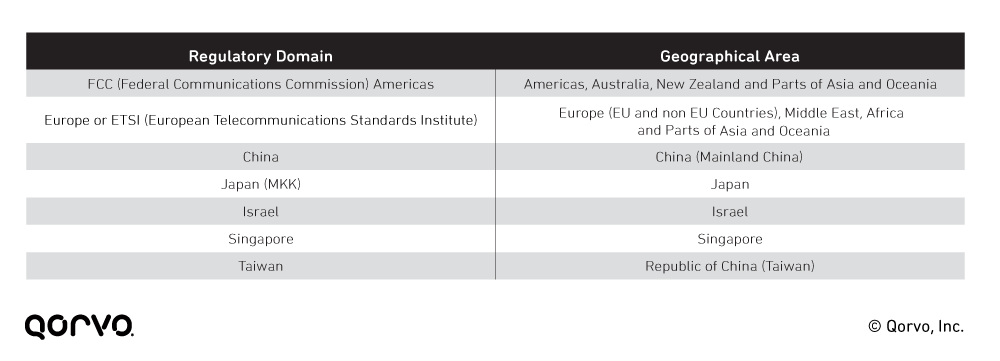
Regional regulatory domains apply differing criteria in areas such as channel usage and power level when monitoring Wi-Fi bands. For example, the U.S. Federal Communications Commission (FCC) requires the use of channels 1 through 11, while the EU uses channels 1 through 13 (Figure 2). The permitted RF output power levels also differ slightly between the Americas and the EU.
Figure 2. Global Wi-Fi Frequency Ranges
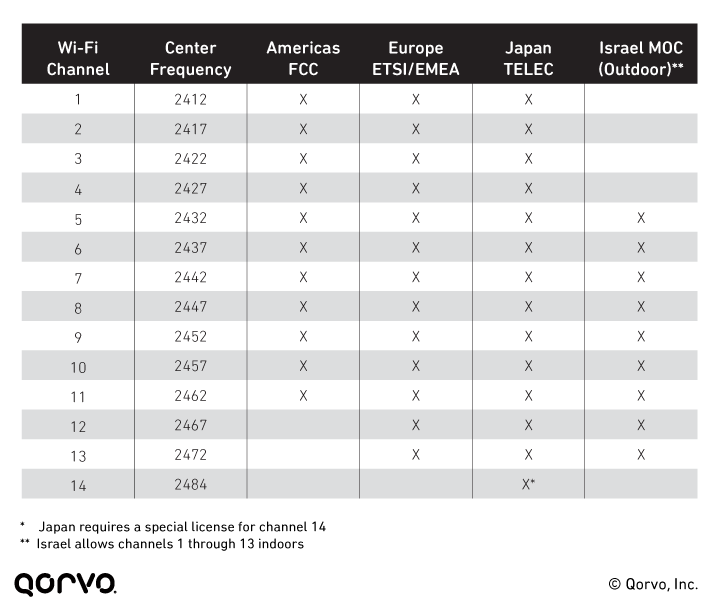
Solving the challenge. It’s important to gain an understanding of all relevant regional requirements prior to beginning the design. Armed with a clear understanding, designers can focus on minimizing the number of SKUs while meeting all relevant regional Wi-Fi requirements.
Thermal Considerations and Requirements
Thermal issues are a critical consideration in Wi-Fi CPE units. RF complexity is increasing as access points integrate more standards and capabilities, including mesh networking. This added complexity further builds the risk of thermal problems. In a home environment, today’s products can reach internal temperatures of 60°C or more when the room temperature is only 25°C. Overlooking these thermal considerations can endanger critical FCC or EU certification, resulting in additional redesign costs and delaying time to market.
Several trends contribute to the overall increases in RF complexity and thermal output within Wi-Fi access points:
- More radios to support multiple wireless standards. Many Wi-Fi access points now incorporate more than just Wi-Fi — they also support standards such as Zigbee, Bluetooth, Bluetooth low energy (BLE) and Thread. In addition, operators are starting to use cellular signals to access Internet of Things devices in home environments, using standards such as LTE-M and NB-IoT. As more radios are added to access points to support this diverse range of standards, the result is greater heat output.
- MIMO and dual-band Wi-Fi. Access points now include MIMO (multiple input-multiple output) and Multiuser MIMO to deliver greater capacity and speed to users, as well as supporting both the 2.4 GHz and 5 GHz Wi-Fi bands. This means access points may include up to eight separate 2.4 GHz and eight 5 GHz RF paths — a massive increase in complexity and potential thermal issues (Figure 3).
- More users and devices. Households no longer have only one or two devices connected to the home router. Today, there may be many users and devices simultaneously accessing the CPE unit, using several standards in addition to Wi-Fi. This means more radios working simultaneously which increases the heat produced inside the unit.
- Smaller, sleeker units for both inside and outside use. Wi-Fi manufacturers are making Wi-Fi units smaller, sleeker, and more decorative. They’re also sealing some units to make them weather-resistant for outdoor use. These changes can make it harder to dissipate heat from the unit. In addition, some manufacturers are adding functions such as night lights, which generate additional heat.
- Wall mount or table top. Wall-mounted units typically generate more heat than units designed for table-top use as there is frequently less room built in for much-needed ventilation and the overall surface area available to release built up heat is reduced.
Figure 3. Increased Number of RF Chains Results in Higher Unit Temperatures
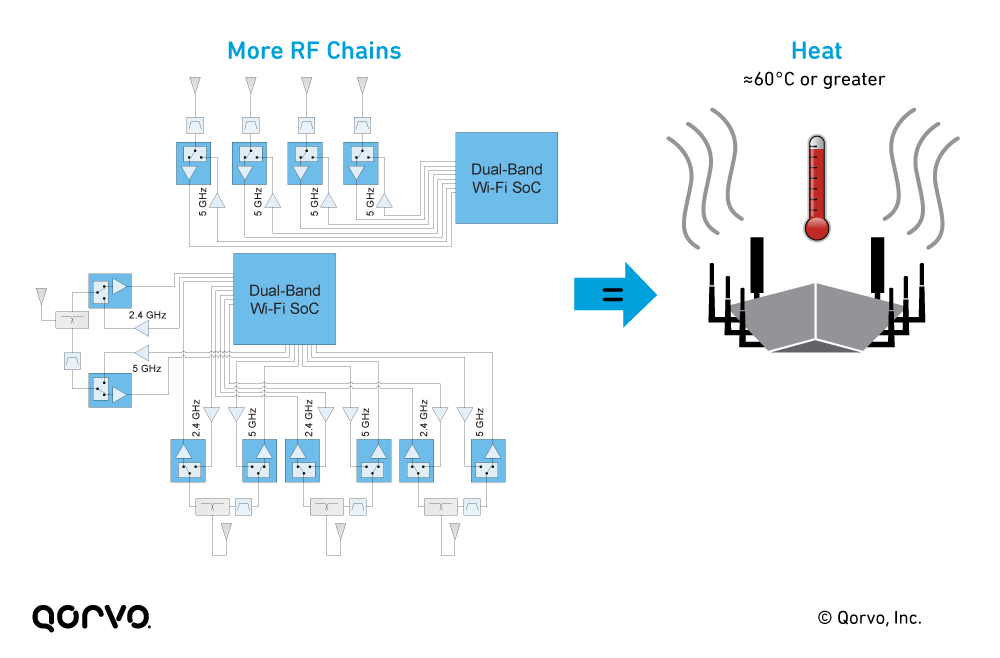
Solving the challenge. Engineers who strive to address thermal issues earlier in their unit design process have a better chance of success. Adding a heatsink or fan to the design is costly — but it’s even more expensive to retrofit them after failing certification. Because access points now include so many RF paths and radios, it is critical to choose components that minimize thermal issues. Seeking out RF front-end (RFFE) modules and other components with lower power dissipation and reduced thermal drift will greatly reduce the risk of thermal issues for the unit.
Module Pin-Out Compatibility
Early in any design process there is a basic understanding of the features that the Wi-Fi unit will have, including software aspects. When selecting RF modules, it’s important to consider not only performance but also whether they will be able to communicate with other components. Electronic components in the Wi-Fi unit communicate with each other via logic pins. These GPIO (general purpose input/output) pins are controlled by software. Problems can be caused by a mismatch between the pin configurations of different components within the system.
Figure 4. Example: RFFE Module Slave Discrete Configurations and Their Operating Modes
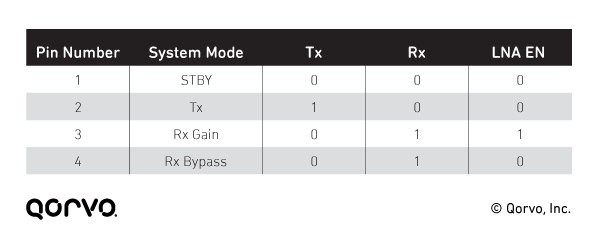
Solving the challenge. While designing and laying out the integrated circuitry within the unit, be sure to account for how each component will communicate with others. Ensure that you choose components (such as RFFE modules) that have the correct number and layout of logic pin inputs/outputs. This will ensure they can communicate with other devices within your design and the components logic table (Figure 4).
Wireless Coexistence and Interference
Wireless devices are everywhere. With the large number of radios and RF signal paths within and around Wi-Fi CPE devices, there are inevitable concerns about coexistence and interference. For example, smartphone LTE radios near the unit or even smart light bulbs operating in the 2.4 GHz band can interfere with the Wi-Fi signal, causing performance issues (Figure 5).
Figure 5. Possible Wi-Fi Interferences
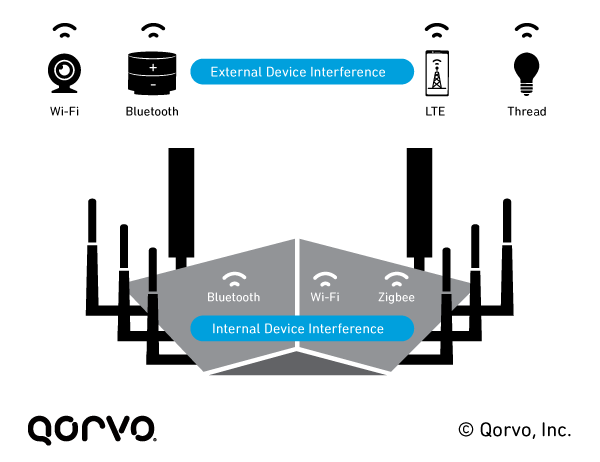
Solving the challenge. RF Filters are key to solving potential interference issues, helping to ensure the CPE unit can meet regulatory requirements in the U.S. and other countries. RF filters prevent interference between Wi-Fi signals and neighboring frequencies used by other standards; they are available as discrete components and embedded into RFFE modules.
One concern with RF filters is thermal drift as the frequency response tends to shift when the temperature changes. This can reduce the unit’s performance, increase power consumption and even cause problems with certification, so it’s important to choose filters with low thermal drift. The issue is often overlooked, because designers typically create products at room temperature and bench-test at the same temperature. However, in a real-life customer application the unit’s internal temperature can soar to 60°C or even 80 °C.
Filters based on bulk acoustic wave (BAW) technology are ideal for Wi-Fi products because they have best-in-class temperature stability, which provides advantages during certification testing by the FCC or other regulatory bodies.
BAW Wi-Fi band-edge filters also allow designers to push the limit of RFFE output power even when using channels at the edges of the allocated Wi-Fi spectrum, while staying within FCC requirements for power spectral density. Band-edge BAW filtering therefore allows operators and manufacturers to deliver high-speed data and wide bandwidth by exploiting spectrum that might otherwise be unusable.
PCB Layout and Mechanical Design
During PCB layout, it is important to avoid chipset pin-out RF crossovers, such as a transmit line passing over a receive trace. All too often a board layout is completed, and the engineer finds out one or more RF lines are not properly isolated from other RF pathways. This can be a big headache if it is discovered near the final testing or certification stage of the design.
Solving the challenge. Communication between the design teams is essential to mitigate these issues. Working cohesively on the system design from an early stage can increase your chances for success and allow design teams to catch potential issues early, before they cause problems.
Summary
Wi-Fi CPE devices play an integral role in people’s lives, delivering convenient services, immediate access to information, and greater efficiency. But creating these extremely complex devices can be tricky. The keys to successful Wi-Fi CPE designs are communication between designers, knowing what to look for in advance and approaching the design as a system. Choosing the right RFFE products can result in fewer SKUs and mitigate or solve system-level design challenges such as thermal and coexistence issues. This leads to fewer design iterations, faster time to market and a better ability to meet FCC certification requirements.
